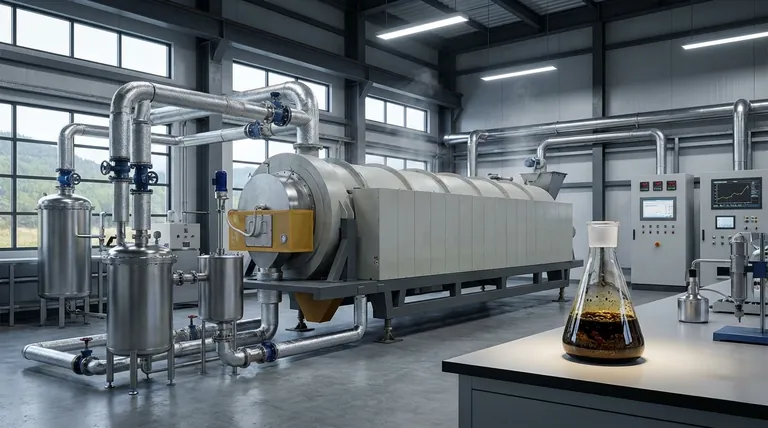To characterize bio-oil is to describe it as a complex, dark liquid with a high water and oxygen content, which results in a significantly lower heating value compared to conventional fossil fuels. This unique composition, derived from the rapid heating of biomass, presents both challenges for its use as a direct fuel and opportunities for its role as a chemical feedstock.
The defining characteristics of bio-oil—notably its high water and oxygen levels—are not simply academic details. They are the fundamental reasons it cannot be used as a simple "drop-in" replacement for fuels like diesel or heating oil without significant upgrading.

The Defining Properties of Bio-Oil
To understand bio-oil's potential, we must first be clear about its inherent chemical and physical nature. These properties dictate its handling, storage, and application.
Significant Water Content
Bio-oil contains a substantial amount of water, typically ranging from 14% to 33% by weight. This is not simply surface moisture; it is deeply emulsified within the liquid.
Above a certain threshold, this water can cause the oil to separate into distinct phases, creating significant problems for storage, pumping, and combustion.
Lower Heating Value
The most critical performance metric for any fuel is its energy content. The higher heating value (HHV) of bio-oil is between 15 and 22 MJ/kg.
This is roughly half the energy density of conventional fuel oil, which typically has an HHV of 43 to 46 MJ/kg. You would need nearly twice as much bio-oil to produce the same amount of energy.
High Oxygen Content
The primary reason for bio-oil's low heating value is the presence of oxygenated compounds. Oxygen atoms within the fuel molecules do not contribute to energy release during combustion.
This high oxygen content is the fundamental chemical difference between bio-oil and hydrocarbon-based fossil fuels. It makes the oil more polar, acidic, and less stable.
Understanding the Practical Implications
These properties have direct consequences for how bio-oil can be used in real-world systems. Ignoring them leads to operational failure.
The Challenge of Water Removal
The water in bio-oil is not easily removed. Conventional distillation is largely ineffective because the organic compounds in the oil will begin to break down and react at the temperatures required to boil the water.
Poor "Drop-In" Fuel Performance
Due to its low energy density and high water content, bio-oil cannot be used directly in engines or burners designed for conventional fuels. It would lead to poor ignition, incomplete combustion, and potential equipment damage.
Instability and Corrosion
The presence of acids and other reactive oxygenated compounds makes bio-oil inherently unstable and corrosive to many common metals, such as carbon steel. This requires specialized materials for storage tanks and transport lines.
How to Apply This to Your Goal
Your assessment of bio-oil's viability depends entirely on your intended application.
- If your primary focus is direct fuel replacement: Recognize that raw bio-oil is unsuitable and requires significant, costly upgrading processes (like hydrotreating) to remove oxygen and improve its energy density.
- If your primary focus is biorefining or chemical production: View the unique oxygenated compounds not as a flaw, but as a valuable feedstock for producing specialty chemicals, resins, or other high-value materials.
Understanding these core characteristics is the critical first step in evaluating bio-oil as either a next-generation energy source or a sustainable chemical resource.
Summary Table:
| Property | Typical Range | Implication |
|---|---|---|
| Water Content | 14% - 33% by weight | Phase separation, difficult to remove |
| Heating Value (HHV) | 15 - 22 MJ/kg | ~50% lower than conventional fuel oil |
| Oxygen Content | High (Oxygenated compounds) | Low stability, corrosive, requires upgrading |
Ready to explore the potential of bio-oil in your lab? KINTEK specializes in providing the precise lab equipment and consumables needed for bio-oil analysis, characterization, and upgrading research. Our experts can help you select the right tools to accurately measure properties like water content, heating value, and chemical composition. Contact us today to discuss your specific laboratory needs and discover how KINTEK can support your bio-energy and biorefining projects.
Visual Guide

Related Products
People Also Ask
- What is the meaning of rotary furnace? Achieve Superior Uniformity in Continuous Heat Treatment
- What is a rotary kiln reactor? A Guide to Industrial Thermal Processing
- What are the zones in rotary kiln in cement production? Master the Core Process for High-Quality Clinker
- What are the equipment for pyrolysis laboratory? Choosing the Right Reactor for Your Research
- How is energy converted into biomass? Harnessing Nature's Solar Power for Renewable Energy
